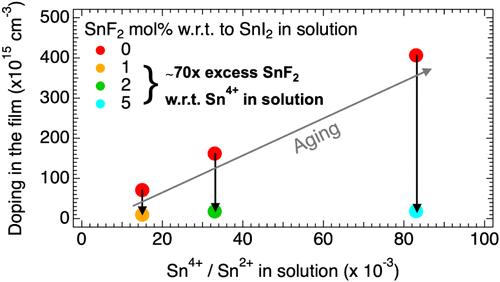Quantitative Analysis of the Doping and Defect Density in Mixed Sn–Pb Perovskites Mediated by SnF2
IF 7
2区 材料科学
Q2 CHEMISTRY, PHYSICAL
引用次数: 0
Abstract
Last year’s mixed Sn–Pb perovskites have been applied as low-bandgap absorbers in efficient solar cells. However, the performance is still limited by tin oxidation, resulting in doping and defects. Here we perform a quantitative analysis on how tin oxidation affects the optoelectronic properties of spin-coated Cs0.25FA0.75Sn0.5Pb0.5I3 with varying SnF2 additions ranging from 0 to 20 mol %. First, optical spectroscopy is used to determine the fraction of Sn4+ in the spin-coating solution, which varies depending on the purity of the starting SnI2 precursor. By applying steady-state microwave conductance, a large decrease in the dark conductivity from ∼100 to <∼1 S m–1 in the spin-coated films on going from 0 to 2 mol % SnF2 is observed. We conclude that, without SnF2, ∼12% of the Sn4+ in solution leads to mobile carriers in the form of free holes, p0, in the perovskite layer. Upon SnF2 addition, p0 decreases to <1 × 1016 cm–3. We infer that a ∼70 times excess of SnF2 over the initial concentration of Sn4+ in solution is required to scavenge the Sn4+ and obtain layers with reduced doping. Although the reduction of p0 and defects results in increased carrier lifetimes, higher SnF2 additions are also required to decrease the surface defects, leading to even longer lifetimes close to 200 ns. The reduced doping of these perovskite films with SnF2 makes them ideal candidates for efficient solar cells; however, SnF2 also induces compositional heterogeneity and accumulation of SnOx at the surface.

SnF2介导的混合Sn-Pb钙钛矿掺杂和缺陷密度的定量分析
去年的混合Sn-Pb钙钛矿已经作为低带隙吸收剂应用于高效太阳能电池。然而,性能仍然受到锡氧化的限制,导致掺杂和缺陷。本文定量分析了在SnF2添加量为0 ~ 20 mol %的情况下,锡氧化对自旋涂覆Cs0.25FA0.75Sn0.5Pb0.5I3光电子性能的影响。首先,利用光谱学来确定自旋镀膜溶液中Sn4+的含量,Sn4+的含量取决于起始sn2前驱体的纯度。通过应用稳态微波电导率,观察到自旋涂层薄膜的暗电导率在SnF2从0 mol %增加到2 mol %时从~ 100下降到~ 1 S m-1。我们得出结论,在没有SnF2的情况下,溶液中~ 12%的Sn4+在钙钛矿层中以自由空穴p0的形式形成可移动的载流子。加入SnF2后,p0减小为1 × 1016 cm-3。我们推断,SnF2比溶液中Sn4+的初始浓度多出~ 70倍,才能清除Sn4+并获得掺杂减少的层。虽然p0和缺陷的减少导致载流子寿命的增加,但也需要更高的SnF2添加来减少表面缺陷,从而导致更长的寿命接近200 ns。这些钙钛矿薄膜与SnF2的掺杂减少,使它们成为高效太阳能电池的理想候选者;然而,SnF2也会导致表面SnOx的成分不均匀性和堆积。
本文章由计算机程序翻译,如有差异,请以英文原文为准。
求助全文
约1分钟内获得全文
求助全文
来源期刊

Chemistry of Materials
工程技术-材料科学:综合
CiteScore
14.10
自引率
5.80%
发文量
929
审稿时长
1.5 months
期刊介绍:
The journal Chemistry of Materials focuses on publishing original research at the intersection of materials science and chemistry. The studies published in the journal involve chemistry as a prominent component and explore topics such as the design, synthesis, characterization, processing, understanding, and application of functional or potentially functional materials. The journal covers various areas of interest, including inorganic and organic solid-state chemistry, nanomaterials, biomaterials, thin films and polymers, and composite/hybrid materials. The journal particularly seeks papers that highlight the creation or development of innovative materials with novel optical, electrical, magnetic, catalytic, or mechanical properties. It is essential that manuscripts on these topics have a primary focus on the chemistry of materials and represent a significant advancement compared to prior research. Before external reviews are sought, submitted manuscripts undergo a review process by a minimum of two editors to ensure their appropriateness for the journal and the presence of sufficient evidence of a significant advance that will be of broad interest to the materials chemistry community.
 求助内容:
求助内容: 应助结果提醒方式:
应助结果提醒方式:


